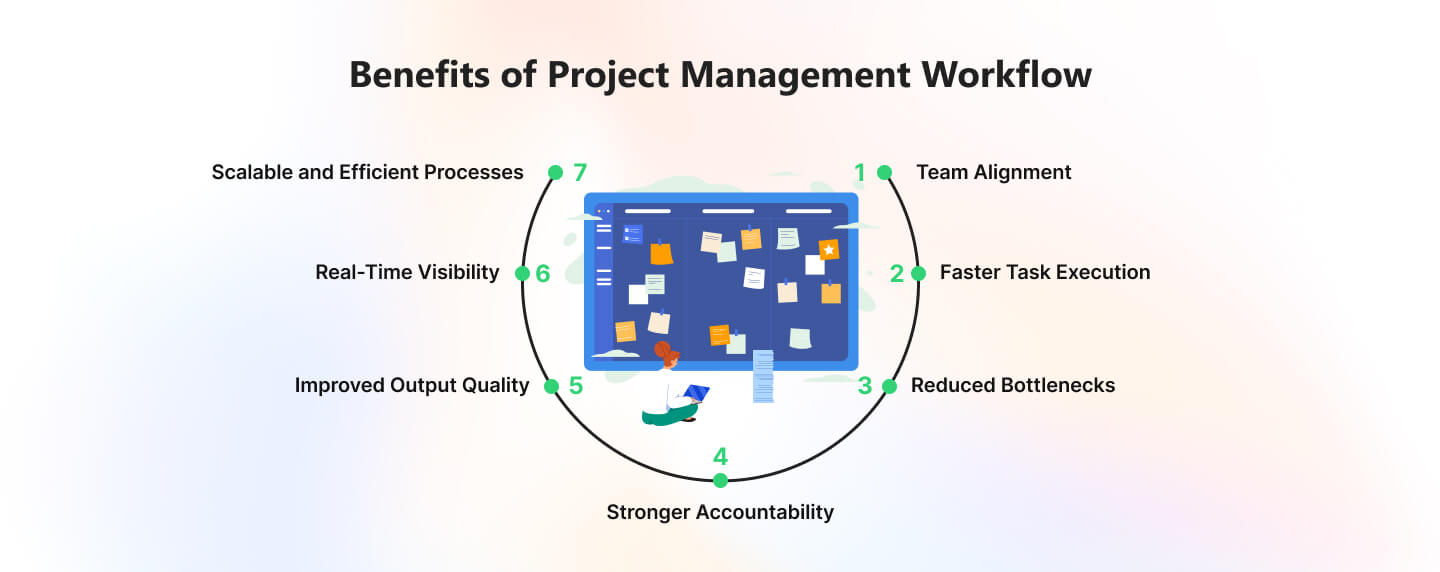
In a world where projects move faster than ever and teams rarely share the same office, a scattered approach simply doesn’t cut it. A clear project management workflow is the backbone of delivering work on time, on budget, and without burnout. Without a structured process, teams risk miscommunication, missed deadlines, and stalled progress.
A well-defined workflow turns project chaos into clarity. It aligns stakeholders, streamlines task execution, and ensures that every phase, from initiation to delivery, runs smoothly and efficiently.
In this guide, we’ll break down the key components of an effective project management workflow, explore best practices, and show you how to implement a system that drives productivity, accountability, and results across your organization.
Whether you’re managing a small team or a complex, cross-functional initiative, this guide will equip you with the tools and frameworks to work smarter — not harder.
What Is Project Workflow Management?
Project workflow management is the practice of organizing and guiding the flow of tasks, information, and approvals needed to complete a project successfully. It focuses on the sequence of actions: who does what, when, and how, to ensure that work moves smoothly from one stage to the next.
Unlike broader project management, which includes budgeting, resourcing, and stakeholder communication, workflow management zooms in on execution. It provides a structured framework that helps teams break down complex objectives into repeatable steps, identify dependencies, and prevent bottlenecks before they disrupt progress.
A well-managed workflow not only improves team coordination but also boosts visibility, accountability, and efficiency. It gives every team member a clear understanding of their role, timelines, and deliverables while allowing managers to monitor progress in real time and adjust priorities as needed.
In short, project workflow management is what turns plans into action. It’s the operational engine that drives a project from kickoff to completion with fewer delays, less confusion, and better outcomes.

Benefits of Project Management Workflows
A well-designed project workflow is more than just a checklist. It is the foundation that supports efficient, high-performing teams. By establishing a clear process from start to finish, workflows bring structure, consistency, and direction to project execution.
Here are the key benefits:
1. Improved Team Alignment
When the entire team understands the workflow, collaboration becomes smoother and confusion is minimized. Each team member knows what is expected of them, when tasks are due, and how their work contributes to the overall project. This clarity enhances communication and keeps everyone moving in the same direction.
2. Faster Task Completion
Without a clear process, teams often waste time figuring out what to do next. A defined workflow outlines each step, assigns responsibilities, and sets priorities, allowing team members to complete tasks more efficiently and focus on high-value work.
3. Fewer Bottlenecks and Delays
Projects often stall due to unclear handoffs or overlooked dependencies. A good workflow highlights these connections in advance, making it easier to identify potential issues and take corrective action before they slow down the project.
4. Greater Accountability
With specific roles, responsibilities, and timelines clearly outlined, accountability naturally increases. Everyone involved can see who is responsible for each task, which helps ensure that deadlines are met and expectations are managed effectively.
5. Higher Quality Output
Consistency leads to better results. Structured workflows help maintain quality standards by including review checkpoints and predefined processes for approvals. This reduces the chances of errors and ensures that every deliverable meets the required standards.
6. Real-Time Visibility and Reporting
Many workflow management tools provide real-time dashboards and progress tracking. This gives project managers and stakeholders full visibility into what is happening at every stage. Having access to up-to-date information enables better decisions and quicker adjustments when priorities shift.
7. Scalability and Process Optimization
Workflows are essential for growing teams and organizations. They make it easier to onboard new members, replicate successful processes, and manage multiple projects without losing control. Over time, workflows can also be analyzed and refined for even greater efficiency.
By bringing clarity and structure to daily work, project workflows help teams stay focused, reduce stress, and deliver results with confidence. Whether you are managing a small internal project or a complex multi-team initiative, the right workflow can be a game changer.
Common Types of Workflows
Not all projects follow the same path. The type of workflow you choose depends on your team’s structure, the complexity of your tasks, and the nature of your work. Below are the most common types of workflows used in project management:
1. Sequential Workflow
Tasks are completed in a fixed, linear order. One step must be finished before the next can begin. This type is best for projects with clearly defined phases and dependencies, such as construction, manufacturing, or compliance-based work.
2. Parallel Workflow
Multiple tasks occur simultaneously across different teams or departments. This model is ideal for speeding up timelines when several independent actions can be performed at once, such as in marketing campaigns or product launches.
3. Rule-Based Workflow
Steps are triggered automatically based on set conditions or rules. Often used in automation systems, this type of workflow is common in software development, customer onboarding, and approval processes.
4. State Machine Workflow
Work does not follow a strict path from start to finish. Instead, tasks move between various states depending on actions or events (e.g. draft, review, revision, approved). This flexible model works well for creative or iterative projects where tasks evolve over time.
5. Ad Hoc Workflow
Designed for flexibility, ad hoc workflows are informal and dynamic. They are built in real time by team members based on project needs. While less structured, they are useful in fast-moving environments or projects with unpredictable elements.
Each workflow type has its advantages. The right choice depends on how structured your project needs to be, how your team operates, and how much flexibility the process requires.

How to Build an Effective Workflow (Step-by-Step)
An effective workflow is the engine behind consistent, high-quality project delivery. It connects people, tasks, and tools into a cohesive process that can be repeated, scaled, and improved over time. Whether you’re starting from scratch or optimizing an existing system, the steps below will guide you through building a workflow that fits your team and goals.
1. Define the Objective
Every workflow starts with a purpose. What are you trying to achieve? This could be launching a new product, delivering client work, or completing a campaign. Defining the end goal keeps the process focused and ensures every task contributes to the bigger picture. Be specific. A clear objective helps guide every decision you make while building the workflow.
2. Identify Key Tasks and Milestones
Break down the project into individual tasks. What needs to happen for the goal to be achieved? Group related tasks into phases, and mark significant milestones along the way. These milestones serve as checkpoints to evaluate progress and adjust course if needed. At this stage, it’s important to involve team members who will be executing the tasks, they often provide valuable insights into the actual steps required.
3. Assign Roles and Responsibilities
One of the most common causes of project delays is lack of clarity on ownership. Every task in the workflow should have a clearly assigned owner. Define who is responsible for completing the task, who needs to review it, and who makes the final approval. Assigning responsibilities in advance improves accountability, prevents overlap, and ensures a smoother handoff between stages.
4. Map the Workflow Sequence
Now it’s time to structure the workflow. Determine the order in which tasks should be completed. Identify dependencies, and decide which steps can happen simultaneously. Use visual tools such as flowcharts, Kanban boards, or Gantt charts to map out the full sequence. This step turns a list of tasks into a logical, trackable process that can be followed and optimized.
5. Choose the Right Tools
Your workflow is only as good as the tools supporting it. Select a project management platform that aligns with the way your team works. Tools like Tasx, Asana, Jira, or ClickUp help organize tasks, track progress, assign responsibilities, and communicate updates in real time. Look for features like automation, integrations, and custom views that fit your project needs.
6. Set Deadlines and Timeframes
Timing is critical. Define how long each task should take and when it should be completed. Be realistic with deadlines, but also ensure there’s enough urgency to keep the project moving. Add buffer time for reviews, unexpected changes, and revisions. Well-planned schedules help avoid last-minute scrambles and make workload management easier for everyone involved.
7. Automate Repetitive Tasks
Identify parts of the workflow that happen frequently and don’t require manual intervention. This could include sending notifications, assigning tasks when a milestone is reached, or updating task statuses. Most project management tools offer automation features that save time and reduce human error. Automating routine actions allows your team to focus on meaningful work.
8. Test the Workflow and Gather Feedback
Before implementing the workflow across your entire team or organization, test it with a small group or pilot project. Observe how the process functions in real-world conditions, and gather feedback from those involved. Are tasks flowing smoothly? Are responsibilities clear? Are there unnecessary steps or gaps? Use this input to refine and improve the workflow.
9. Document the Process
Once the workflow is finalized, document it. Create a workflow guide or internal documentation that outlines each step, role, and expectation. This makes onboarding new team members easier and helps maintain consistency over time. Well-documented workflows become reusable assets that improve with each iteration.
10. Monitor, Review, and Improve
Even the best workflow can be improved. Track performance metrics, monitor for delays or blockers, and encourage regular feedback from the team. Set periodic check-ins to review what’s working and what’s not. Over time, your workflow should evolve to meet new challenges, team structures, or project types.
Building an effective workflow is not a one-time task — it’s a continuous process of refinement. But the reward is a team that works with confidence, clarity, and coordination. When your workflow fits your goals and adapts to your needs, project success becomes a habit, not a struggle.
Workflow Best Practices for Teams
Even the best-designed workflow needs smart practices to truly succeed. As teams grow, priorities shift, and tools evolve, keeping workflows functional, flexible, and efficient becomes a continuous effort. These best practices will help your team maintain high performance and adaptability over time.
Keep it Simple and Scalable
Complexity slows teams down. A good workflow should be easy to understand and follow, even for new team members. Focus on clarity: define only what’s necessary, eliminate unnecessary steps, and avoid over-engineering the process. Start small, then scale. As your team grows or your projects become more complex, a simple foundation makes it easier to evolve without friction.
Use Templates and Repeatable Structures
Don’t start from scratch every time. For projects that follow a similar structure — such as onboarding, marketing campaigns, or feature releases — create templates that outline common steps, roles, and timelines. Templates ensure consistency, reduce setup time, and minimize the chance of missing important tasks. Most project management tools support reusable workflows that can be easily duplicated and customized.
Automate Recurring Steps
Repetitive tasks can quietly drain productivity. By automating routine actions — such as assigning tasks, sending reminders, updating statuses, or routing approvals — you free up your team’s time for more strategic work. Automation also reduces errors and keeps the workflow moving without manual intervention, especially in fast-paced environments.
Review and Adjust Regularly
No workflow is perfect from day one. The most effective teams treat their workflows as living systems. Review performance metrics, track where delays happen, and gather feedback from team members actively using the process. Regular reviews help identify inefficiencies, bottlenecks, or outdated steps so you can fine-tune the workflow and keep it aligned with your current goals.
Make Roles and Expectations Clear
Confusion about who does what is a common source of delays. Ensure that every step in the workflow has a clear owner, and that all team members understand their responsibilities. When expectations are transparent, accountability increases and collaboration becomes smoother.
Document Everything
Clear documentation ensures that workflows can be followed, replicated, and refined by anyone on the team — even new hires. Create step-by-step guides, checklist templates, and quick reference docs to keep everyone on the same page. Documentation also makes it easier to troubleshoot problems and train team members.
By following these best practices, your workflows become more than just process maps — they turn into high-performing systems that support your team’s productivity, reduce friction, and enable consistent project success.
Common Workflow Mistakes to Avoid
Even well-intentioned workflows can fall short if common pitfalls aren’t addressed. Understanding what not to do is just as important as knowing best practices. Below are some of the most frequent mistakes teams make when building and managing workflows — and how to avoid them.
Overcomplicating the Process
Trying to include every possible scenario or step can make workflows confusing and difficult to follow. Complex processes often slow down execution and overwhelm team members. Instead, aim for simplicity. Focus on what’s essential and leave room for flexibility where needed.
Ignoring Team Input
Workflows should serve the people who use them. When workflows are created in isolation without input from those executing the tasks they often miss important context or create friction in day-to-day work. Involve your team early in the process, gather feedback regularly, and treat them as co-creators of the system.
Lack of Documentation
A workflow is only as good as its clarity. Without proper documentation, team members may interpret steps differently or miss key tasks altogether. Document each phase, responsibility, and expectation clearly so that everyone has a reliable point of reference. This is especially important for onboarding new team members or scaling operations.
Not Reviewing or Updating the Workflow
A static workflow quickly becomes outdated. Business needs change, teams evolve, and new tools become available. Failing to revisit and improve your workflow can lead to inefficiencies, confusion, or missed opportunities. Schedule regular reviews to keep the process relevant, optimized, and aligned with current goals.
Avoiding these mistakes will help you build workflows that are not only functional but also sustainable, adaptable, and embraced by your team.
Conclusion
An effective project management workflow is more than just a sequence of tasks – it’s a strategic framework that helps teams stay aligned, efficient, and focused from start to finish. By clearly defining objectives, structuring processes, assigning responsibilities, and leveraging the right tools, organizations can turn complex projects into repeatable success stories.
As your team grows or your goals evolve, so should your workflow. Regular reviews, feedback loops, and a willingness to adapt are key to long-term efficiency and scalability.
Whether you’re building your first workflow or refining an existing one, following the principles in this guide will help you reduce friction, boost accountability, and deliver better outcomes consistently.



